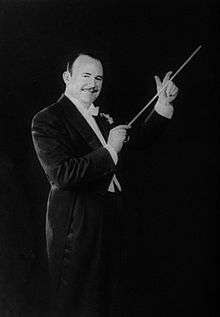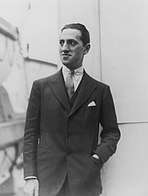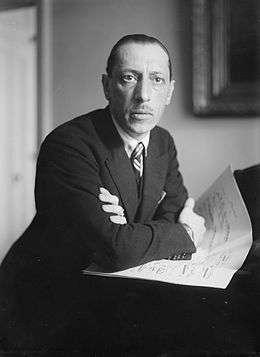Rhapsody in Blue
Rhapsody in Blue is a 1924 musical composition by the American composer George Gershwin for solo piano and jazz band, which combines elements of classical music with jazz-influenced effects.
| Rhapsody in Blue | |
|---|---|
| by George Gershwin | |
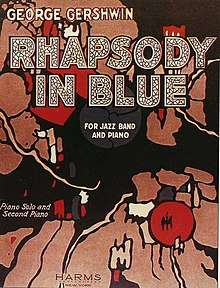 Cover of the original sheet music of Rhapsody in Blue | |
| ISWC | T-070.126.537-3 |
| Genre | Orchestral jazz |
| Form | Rhapsody |
| Composed | 1924 |
| Premiere | |
| Date | February 12, 1924 |
| Location | Aeolian Hall, New York City, New York, US |
| Conductor | Paul Whiteman |
| Performers | George Gershwin (piano) |
The composition was commissioned by the bandleader Paul Whiteman. It was orchestrated by Ferde Grofé several times, including the original 1924 scoring, the 1926 "theater orchestra" setting, and the 1942 symphony orchestra scoring, though completed earlier. The piece received its premiere in the concert, An Experiment in Modern Music, which was held on February 12, 1924, in Aeolian Hall, New York City, by Whiteman and his band with Gershwin playing the piano.[1]
The editors of the Cambridge Music Handbooks opined that "the Rhapsody in Blue (1924) established Gershwin's reputation as a serious composer and has since become one of the most popular of all American concert works."[2]
History
Commission
After the success of an experimental classical-jazz concert held with the Canadian singer Éva Gauthier at Aeolian Hall in New York City on November 1, 1923, the bandleader Paul Whiteman decided to attempt something more ambitious.[3] He asked George Gershwin to contribute a concerto-like piece for an all-jazz concert he would give in Aeolian Hall in February 1924. Whiteman became interested in featuring such an extended composition by Gershwin in the concert after he had collaborated with Gershwin in the Scandals of 1922, impressed by the original performance of the one-act opera Blue Monday, which was nevertheless a commercial failure. Gershwin declined on the grounds that, as there would certainly be need for revisions to the score, he would not have enough time to compose the new piece.[4]
Late on the evening of January 3, at the Ambassador Billiard Parlor at Broadway and 52nd Street in Manhattan, while George Gershwin and Buddy De Sylva were playing billiards, his brother Ira Gershwin was reading the January 4 edition of the New York Tribune.[4][5] An article entitled "What Is American Music?" about the Whiteman concert caught his attention, in which the final paragraph claimed that "George Gershwin is at work on a jazz concerto, Irving Berlin is writing a syncopated tone poem, and Victor Herbert is working on an American suite."[3]
In a phone call to Whiteman next morning, Gershwin was told that Whiteman's rival Vincent Lopez was planning to steal the idea of his experimental concert and there was no time to lose.[6] Gershwin was finally persuaded to compose the piece.
Composition
Since there were only five weeks left, Gershwin hastily set about composing a piece, and on the train journey to Boston, the ideas of Rhapsody in Blue came to his mind.[6] He told his first biographer Isaac Goldberg in 1931:
It was on the train, with its steely rhythms, its rattle-ty bang, that is so often so stimulating to a composer — I frequently hear music in the very heart of the noise. ... And there I suddenly heard, and even saw on paper — the complete construction of the rhapsody, from beginning to end. No new themes came to me, but I worked on the thematic material already in my mind and tried to conceive the composition as a whole. I heard it as a sort of musical kaleidoscope of America, of our vast melting pot, of our unduplicated national pep, of our metropolitan madness. By the time I reached Boston I had a definite plot of the piece, as distinguished from its actual substance.[7][8]
Gershwin began his work on January 7 as dated on the original manuscript for two pianos.[3] The piece was titled American Rhapsody during composition. The title Rhapsody in Blue was suggested by Ira Gershwin after his visit to a gallery exhibition of James McNeill Whistler paintings, which bear titles such as Nocturne in Black and Gold: The Falling Rocket and Arrangement in Grey and Black.[9][10] After a few weeks, Gershwin finished his composition and passed the score to Whiteman's arranger Ferde Grofé, who orchestrated the piece, finishing it on February 4, only eight days before the premiere.[11]
Premiere
Rhapsody in Blue premiered in an afternoon concert on Tuesday, February 12, 1924, held by Paul Whiteman and his band, the Palais Royal Orchestra, titled An Experiment in Modern Music, which took place in Aeolian Hall in New York City.[1] Many important and influential musicians of the time were present, including Victor Herbert,[12] Walter Damrosch,[12] Sergei Rachmaninoff,[13][12] Igor Stravinsky,[13][12] Fritz Kreisler,[13][12] Leopold Stokowski,[13][12] John Philip Sousa,[13] and Willie "the Lion" Smith.[13] The event has since become historic specifically because of its premiere of the rhapsody.
The purpose of the experiment, as told by Whiteman in a pre-concert lecture in front of many classical music critics and highbrows, was "to be purely educational".[14] It would "at least provide a stepping stone which will make it very simple for the masses to understand, and therefore, enjoy symphony and opera". The program was long, including 26 separate musical movements, divided into 2 parts and 11 sections, bearing titles such as "True form of jazz" and "Contrast: legitimate scoring vs. jazzing". Gershwin's latest composition was the second to last piece (before Elgar's Pomp and Circumstance March No. 1).[15] Many of the numbers sounded similar and the ventilation system in the concert hall was broken. People in the audience were losing their patience, until the clarinet glissando that opened Rhapsody in Blue was heard.[16]
The rhapsody was performed by Whiteman's band, with an added section of string players, and George Gershwin on piano. Gershwin decided to keep his options open as to when Whiteman would bring in the orchestra and he did not write down one of the pages for solo piano, with only the words "Wait for nod" scrawled by Grofé on the band score.[17] Gershwin improvised some of what he was playing, and he did not write out the piano part until after the performance, so it is unknown exactly how the original rhapsody sounded.[18]
The opening clarinet glissando came into being during rehearsal when, "... as a joke on Gershwin, [Ross] Gorman (Whiteman's virtuoso clarinettist) played the opening measure with a noticeable glissando, adding what he considered a humorous touch to the passage. Reacting favourably to Gorman's whimsy, Gershwin asked him to perform the opening measure that way at the concert and to add as much of a 'wail' as possible."[19]
The first British performance of Rhapsody in Blue took place at the Savoy Hotel in London on 15 June 1925. It was broadcast in a live relay by the BBC. Debroy Somers conducted the Savoy Orpheans with Gershwin himself at the piano.[20] The piece was heard again in the UK during the second European tour of the Paul Whiteman Orchestra, most notably on April 11, 1926, at the Royal Albert Hall, with Gershwin in the audience. The concert was recorded (though not issued) by HMV.[21]
By the end of 1927, Whiteman's band had played Rhapsody in Blue 84 times, and its recording sold a million copies.[22] To get the whole piece onto two sides of a 12-inch record it had to be played at a faster speed than usual in a concert, which gave it a hurried feel and some rubato was lost. Whiteman later adopted the piece as his band's theme song and opened his radio programs with the slogan "Everything new but the Rhapsody in Blue."[23]
Responses
The piece received mixed reviews from music critics.[24] Samuel Chotzinoff, music critic of the New York World, claimed Gershwin's composition had "made an honest woman out of jazz."[12] Olin Downes, reviewing the concert in The New York Times, wrote:
This composition shows extraordinary talent, as it shows a young composer with aims that go far beyond those of his ilk, struggling with a form of which he is far from being master. ... In spite of all this, he has expressed himself in a significant and, on the whole, highly original form. ... His first theme ... is no mere dance-tune ... it is an idea, or several ideas, correlated and combined in varying and contrasting rhythms that immediately intrigue the listener. The second theme is more after the manner of some of Mr. Gershwin's colleagues. Tuttis are too long, cadenzas are too long, the peroration at the end loses a large measure of the wildness and magnificence it could easily have had if it were more broadly prepared, and, for all that, the audience was stirred and many a hardened concertgoer excited with the sensation of a new talent finding its voice. ... There was tumultuous applause for Gershwin's composition.[1]
Another reviewer, Lawrence Gilman, a Richard Wagner specialist who later wrote a devastating review of Gershwin's Porgy and Bess, commenting on the rhapsody in the New York Tribune on February 13, 1924, said:
How trite, feeble and conventional the tunes are; how sentimental and vapid the harmonic treatment, under its disguise of fussy and futile counterpoint! ... Weep over the lifelessness of the melody and harmony, so derivative, so stale, so inexpressive![25]
Some critics described the piece as formless, and claimed that Gershwin only glued his melodic segments together into one piece. Pitts Sanborn wrote that the music "runs off into empty passage-work and meaningless repetition".[26] In an article in The Atlantic Monthly in 1955, Leonard Bernstein, who nevertheless admitted that he loved the piece,[27] wrote:
Rhapsody in Blue is not a real composition in the sense that whatever happens in it must seem inevitable, or even pretty inevitable. You can cut out parts of it without affecting the whole in any way except to make it shorter. You can remove any of these stuck-together sections and the piece still goes on as bravely as before. You can even interchange these sections with one another and no harm done. You can make cuts within a section, or add new cadenzas, or play it with any combination of instruments or on the piano alone; it can be a five-minute piece or a six-minute piece or a twelve-minute piece. And in fact all these things are being done to it every day. It's still the Rhapsody in Blue.[27][28]
Orchestration
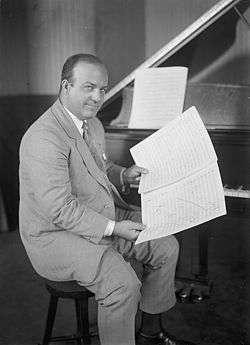
Gershwin had agreed that Ferde Grofé, Whiteman's pianist and chief arranger, was the key figure in enabling the piece to be successful, and critics have praised the orchestral color. Grofé confirmed in 1938 that Gershwin did not have sufficient knowledge of orchestration in 1924.[29] After the premiere, Grofé revised the score and made new orchestrations in 1926 and 1942, each time for larger orchestras.[30] Until 1976, when Michael Tilson Thomas recorded the original jazz band version for the very first time, the 1942 version was the arrangement usually performed and recorded.[30]
The 1924 orchestration was developed for solo piano and Whiteman's band, which consists of three woodwind players doubling one oboe, one heckelphone, one clarinet, one sopranino saxophone in E♭, two soprano saxophones in B♭, two alto saxophones in E♭, one tenor saxophone in B♭, one baritone saxophone in E♭; two trumpets in B♭, two French horns in F, two trombones, and one tuba (doubling on double bass); a percussion section that includes a drum set, timpani, and a glockenspiel; one piano; one tenor banjo; and violins.[31][32]
Grofé's familiarity with the Whiteman band's strengths is a key factor in the scoring.[33] This original version, with its unique instrumental requirements, had lain dormant until its revival in reconstructions beginning in the mid-1980s, owing to the popularity and serviceability of the later scorings, described below.
An arrangement for theatre orchestra, also prepared by Grofé, was published in 1926.[34] It is an adaptation of the original for a more standard "pit" orchestra, which includes one flute, one oboe, two clarinets, one bassoon, three saxophones; two French horns, two trumpets, and two trombones; as well as the same percussion and strings complement as the later 1942 version.[35]
The orchestration published in 1942 for full symphony orchestra is scored for solo piano and an orchestra consisting of two flutes, two oboes, two clarinets in B♭ and A, one bass clarinet, two bassoons, two alto saxophones in E♭, one tenor saxophone in B♭; three French horns in F, three trumpets in B♭, three trombones, one tuba; a percussion section that includes timpani, one suspended cymbal, one snare drum, one bass drum, one tam-tam, one triangle, Glockenspiel, and cymbals; one tenor banjo; and strings.
Grofe's other settings of the piece include those done for Whiteman's 1930 film, King of Jazz, and the concert band setting (playable without piano) completed by 1938 and published 1942. The prominence of the saxophones in the later orchestrations is somewhat reduced, and the banjo part can be dispensed with, as its mainly rhythmic contribution is provided by the inner strings.
Gershwin also made versions of the piece for solo piano as well as two pianos. The solo version is notable for omitting several sections of the piece.[nb 1]
Gershwin's intent to eventually do an orchestration of his own is documented in 1936–37 correspondence from publisher Harms ("reissuance of The Rhapsody in Blue re-scored by yourself for large symphony orchestra").[36]
Recordings
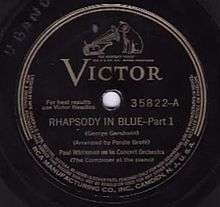
Two recordings exist of Gershwin performing an abridged version of the work with Whiteman's orchestra: an acoustic recording made for the Victor Talking Machine Company on June 10, 1924, and running 8 minutes and 59 seconds (this recording includes the original clarinetist, Ross Gorman, playing the glissando) and a Victor electrical recording made April 21, 1927, running 9 minutes and 1 second (about half the length of the complete work). This 1927 version was also dubbed onto an RCA Victor 33 1⁄3-rpm Program Transcription in 1932. The latter version was actually conducted by Nathaniel Shilkret after an argument between Gershwin and Whiteman.[37] A 1925 piano roll captured Gershwin's performance in a two-piano version.[38] Whiteman's orchestra also performed a shortened version of the piece in the 1930 film The King of Jazz featuring Roy Bargy on piano. Whiteman re-recorded the piece for Decca on a 12-inch 78 rpm disc (29051) recorded on October 23, 1938. The first complete recording, with pianist Jesús María Sanromá and Arthur Fiedler conducting the Boston Pops Orchestra, was issued by RCA Victor in 1935.
Since the mid-20th century, the 1942 version has usually been performed by classical orchestras playing the expanded arrangement. In this form, it has become a staple of the concert repertoire. It has direct popular appeal while also being regarded respectfully by classical musicians.
On August 21, 1945, a recording by Oscar Levant with the Philadelphia Orchestra (conducted by Eugene Ormandy) entered at its peak position of number 23 on the Cash Box survey (Columbia Masterworks 251).
In 1958, the Hamburg Philharmonic Orchestra (conducted by Hans Jurgen Walther with David Haines on piano) recorded an 8:16 version on Somerset Records. The flip side was Joseph Kuhn's Symphony for Blues. The album cover is a nighttime photo of the Chrysler Building and its surroundings with a blue hue.
In 1973, the piece was recorded by jazz-rock artist Eumir Deodato on his album Deodato 2. The single reached Billboard peak positions number 41 Pop, number 10 Easy Listening. A disco arrangement was recorded by French pianist Richard Clayderman in 1978 and is one of his signature pieces.
In the late 1970s, interest in the original arrangement was revived. On February 14, 1973, it received its first performance since the 1920s: Kenneth Kiesler secured needed permissions and led with work with pianist Paul Verrette on his University of New Hampshire campus.[39] Reconstructions of it have been recorded by Michael Tilson Thomas and the Columbia Jazz Band in 1976, and by Maurice Peress with Ivan Davis on piano as part of a 60th-anniversary reconstruction of the entire 1924 concert.[40] André Watts (1976), Marco Fumo (1974), and Sara Davis Buechner (2005) released recordings of the work for solo piano as did Eric Himy (2004) in a version that featured the uncut original short score. Meanwhile, such two-piano teams as José Iturbi and Amparo Iturbi, France Veri and Michael Jamanis, and Katia and Marielle Labèque, also recorded the piece. Michel Camilo recorded the piece in 2006, winning a Latin Grammy award.
Analysis
Paul Whiteman asked Gershwin to write a "jazz concerto", which became the Rhapsody in Blue; like a concerto, the piece is written for solo piano with orchestra: a rhapsody differs from a concerto in that it features one extended movement instead of separate movements. Rhapsodies often incorporate passages of an improvisatory nature (although written out in a score), and are irregular in form, with heightened contrasts and emotional exuberance; Gershwin's Rhapsody in Blue is typical in that it certainly has large contrasts in musical texture, style, and color. The music ranges from intensely rhythmic piano solos to slow, broad, and richly orchestrated sections.
The opening of Rhapsody in Blue is written as a clarinet trill followed by a legato, 17 notes in a diatonic scale. During a rehearsal, Whiteman's virtuoso clarinetist, Ross Gorman, rendered the upper portion of the scale as a captivating (and fully trombone-like) glissando: Gershwin heard it and insisted that it be repeated in the performance.[41] An American Heritage columnist called it the "famous opening clarinet glissando ... that has become as familiar as the start of Beethoven's Fifth".[22] The effect is produced primarily using the tongue and throat muscles to change the resonance of the oral cavity, thus controlling the continuously rising pitch.[42] Many players also gradually open the left-hand tone-holes on the clarinet during the passage from the last concert F (or earlier if possible, thus employing the right hand as well) to the top concert B♭ as well. This effect has now become standard performance practice for the work.
Rhapsody in Blue displays both rhythmic invention and melodic inspiration, and demonstrates Gershwin's ability to write a piece with large-scale harmonic and melodic structure. The piece is characterized by strong motivic interrelatedness. Much of the motivic material is introduced in the first 14 measures. David Schiff identifies five major themes plus a sixth "tag".[9] Of these, two appear in the first 14 measures, and the tag shows up in measure 19. Two of the remaining three themes are rhythmically related to the very first theme in measure 2, which is sometimes called the Glissando theme (after the opening glissando in the clarinet solo) or the Ritornello theme. The remaining theme is the Train theme, which is the first to appear (at rehearsal 9) after the opening material. All of the themes rely on the blues scale, which includes lowered sevenths and a mixture of major and minor thirds. Each theme appears both in orchestrated form and as a piano solo. There are considerable differences in the style of presentation of each theme.
The harmonic structure of the rhapsody is more difficult to analyze. The piece begins and ends in B♭ major, but it modulates towards the sub-dominant direction very early on, returning to B♭ major at the end, rather abruptly. The opening modulates "downward", as it were, through the keys B♭, E♭, A♭, D♭, G♭, B, E, and finally to A major. Modulation through the circle of fifths in the reverse direction inverts classical tonal relationships, but does not abandon them. The entire middle section resides primarily in C major, with forays into G major (the dominant relation). Modulations occur freely and easily, though not always with harmonic direction. Gershwin frequently uses a recursive harmonic progression of minor thirds to give the illusion of motion when in fact a passage does not change key from beginning to end. Modulation by thirds was a common element of Tin Pan Alley music.
The influences of jazz and other contemporary styles are certainly present in Rhapsody in Blue. Ragtime rhythms are abundant, as is the Cuban "clave" rhythm, which doubles as a dance rhythm in the Charleston jazz dance.[24]
Gershwin's own intentions were to correct the belief that jazz had to be played strictly in time so that one could dance to it.[43] The rhapsody's tempos vary widely, and there is an almost extreme use of rubato in many places throughout. The clearest influence of jazz is the use of blue notes, and the exploration of their half-step relationship plays a key role in the rhapsody.[44] The use of so-called "vernacular" instruments, such as accordion, banjo, and saxophones in the orchestra, contribute to its jazz or popular style, and the latter two of these instruments have remained part of Grofé's "standard" orchestra scoring. Gershwin incorporated several different piano styles into the work. He utilized the techniques of stride piano, novelty piano, comic piano, and the song-plugger piano style. Stride piano's rhythmic and improvisational style is evident in the "agitato e misterioso" section, which begins four bars after rehearsal 33, as well as in other sections, many of which include the orchestra. Novelty piano can be heard at rehearsal 9 with the revelation of the Train theme. The hesitations and light-hearted style of comic piano, a vaudeville approach to piano made well known by Chico Marx and Jimmy Durante, are evident at rehearsal 22.[45]
In popular culture
As early as 1955, Rhapsody in Blue served as the inspiration for a composition by the noted accordionist/composer John Serry Sr. which was subsequently published in 1957 (see American Rhapsody).[46]
Rhapsody in Blue has been interpreted as a musical portrait of New York City; it is used in this context in a segment in the 1999 Walt Disney Pictures animated film Fantasia 2000, in which the piece is used as the lyrical framing for a stylized animation set drawn in the style of famed illustrator Al Hirschfeld.[47] It was also used in the opening sequence of Woody Allen's 1979 film Manhattan.
Brian Wilson, leader of The Beach Boys, has said on several occasions that Rhapsody in Blue is one of his favorite pieces. He first heard it when he was two years old, and recalls that he "loved" it. According to biographer Peter Ames Carlin, it was an influence on his Smile album.[48]
Rhapsody in Blue was played simultaneously by 84 pianists at the opening ceremony of the 1984 Summer Olympics in Los Angeles.[49] The piece appears briefly towards the end of the 2000 Danish film Flickering Lights. Herbie Hancock and Lang Lang performed Rhapsody in Blue at the 50th Grammy Awards on February 10, 2008.[50] Since 1980,[51] the piece is used by United Airlines in their advertisements, in pre-flight safety videos, and in the Terminal 1 underground walkway at Chicago O'Hare International Airport.[52][53]
Rhapsody in Blue inspired a collaboration between blind savant British pianist Derek Paravicini and composer Matthew King on a new concerto, called Blue premiered at the South Bank Centre in London in 2011.[54] Rhapsody in Blue was used to dramatically introduce the first appearance of Jay Gatsby in the 2013 film The Great Gatsby.[55]
Preservation status
On September 22, 2013, it was announced that a musicological critical edition of the full orchestral score will be eventually released. The Gershwin family, working in conjunction with the Library of Congress and the University of Michigan, are working to make these scores available to the public.[56][57] Though the entire Gershwin project may take 30 to 40 years to complete, the Rhapsody in Blue edition will be an early volume.[58][59]
Rhapsody in Blue entered the public domain on January 1, 2020, although individual recordings of it may remain under copyright.[60][61]
References
Notes
- The omissions include the bars from rehearsal mark 14 to halfway through the fifth bar of rh. 18; from two bars before rh. 22 to the fourth bar of rh. 24; and the first four bars of rh. 38.
Footnotes
- Downes 1924, p. 16.
- Schiff 1997, book jacket.
- Schiff 1997, p. 53.
- Wood 1996, p. 81.
- Jablonski 1999.
- Greenberg 1998, pp. 64–65.
- Cowen 1998.
- Howard 2003.
- Schiff 1997, p. 13.
- Reef 2000, p. 38.
- Greenberg 1998, p. 69.
- Jenkins 1974, p. 144.
- Wood 1996, p. 85.
- Schwartz 1979, p. 84.
- Schiff 1997, pp. 55–61.
- Greenberg 1998, pp. 72–73.
- Schwartz 1979, p. 89.
- Schwartz 1979, pp. 88–89.
- Schwartz 1979, pp. 81–83.
- Radio Times 1925.
- Royal Albert Hall 1926.
- Schwarz 1999.
- Rayno 2013, p. 203.
- Schneider 1999, p. 180.
- Slonimsky 2000, p. 105.
- Greenberg 1998, pp. 74–75.
- Wyatt & Johnson 2004, p. 297.
- Schiff 1997, p. 4.
- Greenberg 1998, p. 66.
- Greenberg 1998, p. 76.
- Sultanof 1987.
- Levy 2019.
- Bañagale 2014, p. 4.
- Bañagale 2014, p. 43.
- Bañagale 2014, p. 44.
- Ferencz 2011.
- Greenberg 1998, pp. 75–76.
- Schiff 1997, p. 64.
- Smith 1973, p. 10.
- Schiff 1997, pp. 67–68.
- Greenberg 1998, p. 70.
- Chen & Smith 2008.
- Schiff 1997, p. 12.
- Schneider 1999, p. 187.
- Schiff 1997, p. 36.
- Serry 1957.
- Solomon 1999.
- Carlin 2006, pp. 25, 118.
- Bañagale 2014, p. 43; Schiff 1997, p. 1.
- Swed 2009.
- United Airlines 2020.
- Bañagale 2014, pp. 158–173.
- Eldred v. Ashcroft 2003.
- BBC News 2011.
- Bañagale 2014, pp. 156–157.
- The Gershwin Initiative 2013.
- Canty 2013.
- Clague & Getman 2015.
- Clague 2013.
- King & Jenkins 2019.
- Jenkins 2019.
Bibliography
- "A Concert of Syncopated Symphonic Music". Radio Times (90). June 12, 1925. p. 538. Retrieved June 17, 2020.
- "Blind Autistic Man Stuns the Music World". BBC News. September 28, 2011. Retrieved January 24, 2019.
- Bañagale, Ryan Raul (2014). Arranging Gershwin: Rhapsody in Blue and the Creation of an American Icon. Oxford, England: Oxford University Press. doi:10.1093/acprof:oso/9780199978373.001.0001. ISBN 978-0-19-997837-3.CS1 maint: ref=harv (link)
- Canty, Cynthia (October 21, 2013). "The University of Michigan Was Selected for the 'Gershwin Initiative'". Ann Arbor, Michigan: Michigan Radio. Retrieved August 30, 2015.CS1 maint: ref=harv (link)
- Carlin, Peter Ames (2006). Catch a Wave: The Rise, Fall and Redemption of the Beach Boys' Brian Wilson. London: Rodale. ISBN 978-1-59486-899-3.CS1 maint: ref=harv (link)
- Clague, Mark (September 20, 2013). "George and Ira Gershwin Critical Edition". Musicology Now. American Musicological Society. Retrieved August 30, 2015.CS1 maint: ref=harv (link)
- Clague, Mark; Getman, Jessica (2015). "The Editions". The Gershwin Initiative. Ann Arbor, Michigan: University of Michigan. Archived from the original on September 5, 2015. Retrieved August 30, 2015.CS1 maint: ref=harv (link)
- Chen, Jer Ming; Smith, John (2008). "How to Play the First Bar of Rhapsody in Blue". Acoustical Society of America. Archived from the original on April 25, 2013. Retrieved April 28, 2013.CS1 maint: ref=harv (link)
- Cowen, Ron (1998). "George Gershwin: He Got Rhythm". The Washington Post. Retrieved August 30, 2015.CS1 maint: ref=harv (link)
- Downes, Olin (February 13, 1924). "A Concert of Jazz". The New York Times. p. 16. Retrieved June 28, 2020.CS1 maint: ref=harv (link)
- Eldred v. Ashcroft, 01 U.S. 618, p. 67 (United States Supreme Court January 15, 2003) ("Even the $500,000 that United Airlines has had to pay for the right to play George Gershwin's 1924 classic Rhapsody in Blue represents a cost of doing business, potentially reflected in the ticket prices of those who fly.").
- Ferencz, George J. (2011). "Porgy and Bess on the Concert Stage: Gershwin's 1936 Suite (Catfish Row) and the 1942 Gershwin–Bennett Symphonic Picture". The Musical Quarterly. 94 (1–2): 93–155. doi:10.1093/musqtl/gdq019. ISSN 1741-8399.CS1 maint: ref=harv (link)
- Greenberg, Rodney (1998). George Gershwin. London: Phaidon Press. ISBN 978-0-7148-3504-4.CS1 maint: ref=harv (link)
- Howard, Orrin (2003). "Rhapsody in Blue". Los Angeles: Los Angeles Philharmonic Association. Archived from the original on February 23, 2005. Retrieved January 24, 2019.CS1 maint: ref=harv (link)
- Jablonski, Edward (1999). "Glorious George". Cigar Aficionado. Archived from the original on January 17, 2006. Retrieved January 24, 2019.CS1 maint: ref=harv (link)
- Jenkins, Alan (1974). The Twenties. Great Britain: Peerage Books. Retrieved August 1, 2020.CS1 maint: ref=harv (link)
- Jenkins, Jennifer (December 30, 2019). "Public Domain Day 2020". Duke Law School's Center for the Study of the Public Domain. Archived from the original on December 30, 2019. Retrieved January 1, 2020.CS1 maint: ref=harv (link)
- King, Noel; Jenkins, Jennifer (December 30, 2019). "1924 Copyrighted Works To Become Part Of The Public Domain". NPR. Archived from the original on January 4, 2020. Retrieved January 1, 2020.CS1 maint: ref=harv (link)
- Paul Whiteman and His Orchestra (1926). Paul Whiteman Orchestra – Live at the Royal Albert Hall in 1926 (HMV Recording). Royal Albert Hall. Retrieved June 17, 2020.
- Levy, Aidan (2019). ""Rhapsody In Blue" at 90". JazzTimes.
Like a train, Gershwin’s sprawling composition had more moving parts than Whiteman had musicians, even augmented with strings, but the band was so versatile that three reed players managed to play a total of 17 parts, including the oboe-like heckelphone, switching as the music dictated.
CS1 maint: ref=harv (link) - Rayno, Don (2013). Paul Whiteman: Pioneer in American Music, Volume II: 1930-1967. Scarecrow Press. ISBN 978-0-8108-8204-1.CS1 maint: ref=harv (link)
- Reef, Catherine (2000). George Gershwin: American Composer. Greensboro, North Carolina: Morgan Reynolds Publishing. ISBN 978-1-883846-58-9.CS1 maint: ref=harv (link)
- "Rhapsody Remastered". United Airlines. 2020. Retrieved April 27, 2020.
- Schiff, David (1997). Gershwin: Rhapsody in Blue. Cambridge, England: Cambridge University Press. doi:10.1017/CBO9780511620201. ISBN 978-0-521-55077-2.CS1 maint: ref=harv (link)
- Schneider, Wayne, ed. (1999). The Gershwin Style: New Looks at the Music of George Gershwin. New York: Oxford University Press. ISBN 978-0-19-509020-8.CS1 maint: ref=harv (link)
- Schwartz, Charles (1979). Gershwin: His Life and Music. New York: Da Capo Press. ISBN 978-0-306-80096-2.CS1 maint: ref=harv (link)
- Schwarz, Frederick D. (1999). "Time Machine: Seventy-five Years Ago Gershwin's Rhapsody". Vol. 50 no. 1. Archived from the original on May 7, 2006. Retrieved February 17, 2007. Cite magazine requires
|magazine=(help)CS1 maint: ref=harv (link) - Serry, John (1957). American Rhapsody, Copyright: Alpha Music Co (Report). Washington, D.C.: Library of Congress Copyright Office.CS1 maint: ref=harv (link)
- Slonimsky, Nicolas (2000) [1953]. Lexicon of Musical Invective: Critical Assaults on Composers Since Beethoven's Time. New York: W. W. Norton & Company. ISBN 978-0-393-32009-1.CS1 maint: ref=harv (link)
- Smith, Wayne A. (January 27, 1973). "Around the Clock: Rhapsody Revived". The Greenfield Recorder. p. 10.CS1 maint: ref=harv (link)
- Solomon, Charles (1999). "Rhapsody in Blue: Fantasia 2000's Jewel in the Crown". Animation World Magazine . Vol. 4 no. 9. Archived from the original on October 13, 2007. Retrieved January 24, 2019.CS1 maint: ref=harv (link)
- Sultanof, Jeff, ed. (1987). Rhapsody in Blue: Commemorative Facsimile Edition. Secaucus, New Jersey: Warner Brothers Music.
This reproduces Grofé's holograph manuscript from the Gershwin Collection, Music Division, Library of Congress.
CS1 maint: ref=harv (link) - Swed, Mark (August 8, 2009). "Music Review: Lang Lang and Herbie Hancock at the Hollywood Bowl". Culture Monster. Los Angeles Times. Retrieved January 24, 2019.CS1 maint: ref=harv (link)
- "The Gershwin Initiative". University of Michigan School of Music, Theatre & Dance. 2013. Retrieved August 30, 2015.
- Wood, Ean (1996). George Gershwin: His Life and Music. London: Sanctuary Publishing. ISBN 978-1-86074-174-6.CS1 maint: ref=harv (link)
- Wyatt, Robert; Johnson, John Andrew, eds. (2004). "Leonard Bernstein: "Why Don't You Run Upstairs and Write a Nice Gershwin Tune?" (1955)". The George Gershwin Reader: Readers on American Musicians. Oxford University Press. ISBN 978-0-19-802985-4.CS1 maint: ref=harv (link)
